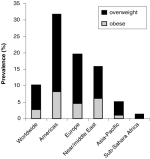Obesity refers to a medical condition whereby a person’s body structure is made up of excessive body fats to an extent that is detrimental to their health. More generally obesity and overweight are defined the same way as conditions where a person body fats are above normal levels (WHO.com). The official definition of World Health Organization (WHO) states that “obesity is a condition where a person has abnormal or excessive fat accumulation that may impair health” (WHO.com). A research study by Lostein et al indicates that worldwide approximately 10% of school going children aged between 5 years and 17 years can be described to be obese; a quarter of whom are at a heightened risk of developing type 2 diabetes (Lobstein, Baur and Uauy).

Based on the present trends, obesity among children is now regarded as one of the major risk factors of type II diabetes. Type II diabetes is generally regarded as a lifestyle disease that occurs later in life and which can largely be prevented with the right type of eating habits and change in lifestyle. This is certainly the main difference between type I diabetes and type II diabetes which is the reason it is most prevalent among obese children. In type II diabetes, the pancreas produces minimal levels of insulin which are not enough to sustain the body functions; an anomaly brought about by change in body systems (Lobstein et al).
Because type II diabetes is intricately related with obesity, let’s briefly review the major risk factors of obesity which can be termed as indirect risk factors of type II diabetes. The major cause that is attributed to the high rate of obesity prevalence in the world today is mainly because of lifestyle changes. The term lifestyle when used in this context describes a particular way of living based on two forms of determinants; types of food eaten and physical activeness (Kim and Willis). One of the major factor that is attributed to overweight in both adults and children is dietary intake of food that are high in fats, sugars and carbohydrates which are more than the maximum amounts that the body requires for it sustenance. When high diets of fats, carbohydrates and sugars are consistently taken over time the result is accumulation of energy that is stored in form of fats within a person’s body leading to excessive weight (Puhl and Heuer).
Lack of exercise is not a cause of obesity per se; rather it is a confounding factor that accelerates the process of obesity given that the body is not actively utilizing the excess energy that is stored in form of body fats. However recent research findings indicates that the cause of obesity or overweight in that case are hardly limited to the two factors mentioned above; obesity is now also determined to be influenced by a person’s genetic makeup, frequency of eating, rate of metabolism, medications, psychological factors and certain diseases all of which varies among different people
Needless to say prevention and management of type II diabetes significantly depends with management and prevention of obesity and overweight. Since obesity is largely a factor of three key determinants; food intake, type of diet and level of physical activity any form of type II diabetes interventions must be structured along these determinants. A framework of addressing challenges caused by overweight and obese conditions has been outlined in “WHO Global Strategy on Diet, Physical Activity and Health” resolution (WHO.com).
References
Kim S., Willis L. Talking about Obesity: News Framing of who is Responsible for Causing and Fixing the Problem. J Health Communic, 12(1) 2007: 359–376. Print
Lobstein, T., Baur, L. & Uauy, R. Obesity in children and young people: a crisis in public health. Obesity Reviews, 5.1 (2004): 4-85. Print
Puhl, R. & Heuer, C. The Stigma of Obesity: A Review and Update. Obesity, 17.5 (2009): 941- 964. Print
WHO.com. Obesity and Overweight: What are Obesity and Overweight? 2007. Web.